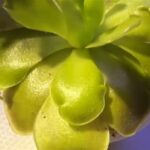As an Amazon Associate, this site earns commissions from qualifying purchases. For more details, click here.
Native to San Luis Potosi, Mexico, pinguicula gypsicola has earned a reputation for being difficult to grow. However with proper care, domestic cultivation is very possible. With its unique appearance, it is going to make a fine addition to your collection.
Pinguicula gypsicola grows in partial to full light at 55-90 F degrees and up to 80% humidity. The soil should be porous with good drainage. During winter the plant sheds its leaves and replaced by a succulent rosette.
Pinguicula Gypsicola Care Sheet
| Soil | 1:1 peat and perlite, soil should be porous |
| Water | Rainwater or distilled |
| Light | Partial to full, natural or indoor grow lights |
| Food | Bugs, freeze dried mealworms, fish food |
| Temperature | 55-90 F (12.7-32 C) |
| humidity | 50-80% |
| Dormancy | No, but goes into non-carnivorous succulent phase |
| Propagation | Cuttings |
Soil
The standard soil mix is equal parts peat and perlite with small amounts of silica sand. You may also use two parts vermiculite, 2 parts perlite and small amounts of aquarium sand. Some cultivators add bits of volcanic lava rocks and gypsum to fortify the roots, but they are optional.
These potting mixes are similar to those used for p. cyclosecta. You can also use them for other butterworts so you can grow different variants with the same materials.
If you are going to buy p. gypsicola, the potting soil is optional. If you decide to buy it, the amount will be sufficient for the accompanying plant. Usually the potting media is enough to fill a 3.5 inch pot.
If you are going to buy soil media separately, make sure they are compatible with p. gypsicola. While you can prepare soil mixes easily, finding the right ratio can be difficult. So if you are new to raising pinguicula, premixed media like Organic Earth Soil Mix is preferable. But if you have experience feel free to try different ratios.
Pot Container
A 3.5 to 5 inch pot is the best for pinguicula gypsicola. Terracotta pots will look nice but you can also use any plastic container.
Most p. gypsicola sold are not potted. A pot may or may not be included, but it is easy to buy one. Check the instructions for the recommended size, which is usually 3.5-5 inches.
Once you have the container, pour the soil into it, adding as much distilled water as necessary. Plant your pinguicula and it is set.
Just like other butterworts, p. gypsicola has small roots which fit well in a small container. A 5 inch tall pot is more than enough, with 3.5 sufficient for many. Repotting is rare for butterworts so you do not need to buy another.
Water
During summer, water from the top so the soil is always moist. When your pinguicula starts to remove its carnivorous leaves in the fall, reduce watering. Let the plant go dry once a succulent rosette is formed. You can leave the plant completely dry if humidity is 80%,
Mist lightly if humidity is low. As winter comes to a close, increase misting frequency. When the plant sheds its rosette and starts growing carnivorous leaves, resume normal watering.
To keep it simple, pinguicula gypsicola needs regular watering in spring and summer. Water as often as necessary so the soil does not dry out. But be careful not to overwater as it could induce root rot. You may try the tray method but keep the level low.
As the temperature drops in the fall, the plant begins to discard its leaves. That is your signal to scale back on watering. When a succulent rosette forms, let the soil dry out.
If humidity is at 80% you can let the plant go dry as there is enough water in the atmosphere. If humidity drops, mist lightly .Do not water all over the rosette however.
Light
Lighting is important for all butterworts, whether you are growing them in pots or planting in rocks. How much you provide can make the difference in its life cycle.
Pinguicula gypsicola grows in partial or full sun. You can leave the plant under full sunlight as long as the temperature does not exceed 90 F.
P. gypsicola can be cultivated indoors or outdoors. If you live in an area with mild weather, you can leave the plant outside. If it gets very hot, partially cover the plant to protect it from heat. You can tell p. gypsicola is getting burned up by how dry its leaves are, which are normally greasy.
Artificial lights. You can use LED and other artificial lights such as Juhefa Grow Lights to supplement natural light. Use only if sunlight is very limited as natural is still better.
Temperature
A temperature range of 55-90 F (12.7-32 C) will allow p. gypsicola to thrive. Note that 90 F is the maximum acceptable. It would be better if day temperature is at 77 F (25 C). Some variants can handle 95 F for short periods.
As long as the reading is under 90 F your butterworts will continue to grow. However, it is just one factor to consider. You also have to look at light, water, soil, food etc. All of these affect the growth and development of the plant,.
Since temperature and light are closely related, you have to consider both. These plants will benefit from a lot light. But as sun intensity goes up, so does the temperature. The best solution is to limit its exposure to direct sunlight during hot days. Another option is to increase humidity to keep the soil from going dry.
Humidity
A humidity rate of 50-80% is enough. Adequate air circulation is needed regardless of the level. It is probably a good idea to use a fan if your pinguicula is in a greenhouse for example.
Humidity provides a lot of benefits for p. gypsicola. High levels in winter eliminates the need for watering. During summer, high moisture levels makes it easier for the plant to secrete mucus for its leaves. Butterworts use mucus to trap insects and eat them, so it is crucial.
If humidity is low, water the plant constantly. While the tray method is not often used, it can work here. Fill a tray with an inch of water and place the pot in it. The water will increase moisture and keep the plant from drying out.
Nutrition and Feeding
Feeding pinguicula gypsicola is similar to other butterworts. They eat insects, freeze dried worms and fish food. These plants only need to feed every 14 days to meet their nutritional requirements.
You only feed the plant in spring and summer. Decide what to give it -insects, fish food or worms- and drop a few onto the leaves. Do not feed all the leaves, just one or two is enough.
You can only give food to p. gypsicola if its leaves have mucus. If the leaves are greasy then it has mucus and can eat prey. But if it is dry, you have to fix that first before giving any food. Increasing humidity is a good place to start.
Nutrition helps these plants grow, but the environment is more important. What you need to do is first, ensure the plant gets enough light, water, humidity and the right soil. Once you do that, your ping will have no problems digesting food.
Keep in mind that butterworts do not need a lot of food. If its leaves always have bugs – even just a few- then you can skip hand feeding. You only have to do this if your ping is in a greenhouse or otherwise unable to catch any food. If it can, do not supply any more nutrients.
Dormancy
Pinguicula gypsicola never goes dormant in winter. Instead it goes through a succulent phase. The plant gets rid of all its carnivorous leaves and replaces them with a succulent rosette.
The rosette is not carnivorous, so no need to feed the plant. While not dormant, p. gypsicola growth is going to be much slower. It does not die however, like other plants.
Once winter ends, you can propagate your plant. Here is a guide on how to propagate butterworts. With p. gypsicola, leaf pullings is the easiest method. It is very difficult to propagate with seeds, and even if you succeed, takes longer compared to leaf pullings.

My fascination with carnivorous plants began many, many years ago with Venus Fly Traps. Now I am more than happy to impart what I know with other enthusiasts and those who are curious about meat eating plants.



